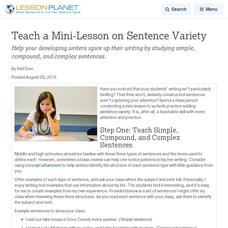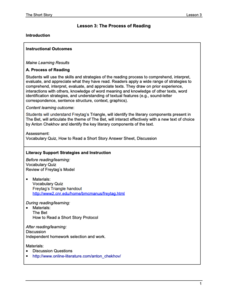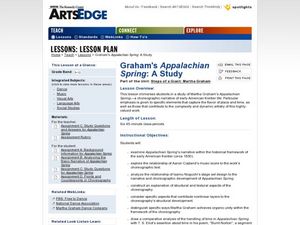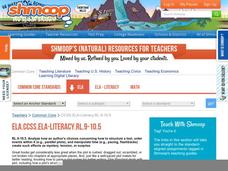Curated OER
How to Make Your Own Website
Students explore technology by creating a web page on-line. In this digital arts lesson, students identify the structure needed to create a website as well as the content required to keep visitors entertained. Students collaborate in...
Curated OER
Periodic Table of Elements
Beginning chemists examine a collection of elements and compounds as they are introduced to the periodic table. The lesson plan is not cohesive and does not provide detailed instructions on how to teach it. However, it does includes a...
Curated OER
Teach a Mini-Lesson Sentence Variety
Help your developing writers spice up their writing by studying simple, compound, and complex sentences.
Curated OER
Laura Joffe Numeroff "If You Give..." Book Activities
Have learners choose activities to complete based on the books by Laura Joffe Numeroff. They are introduced to If You Give a Mouse a Cookie and the other books in this series through prereading activities. They then construct a portfolio...
Curated OER
Sums and Difference of Cubes
Learners factor polynomials using the sum and difference of cubes. They also learn connections between the graph and expression.
Curated OER
Propaganda
How does word choice affect the reading of a text? Compare two headlines that were written about the same event. Is one biased? Discuss how word choice often reveals the author's feelings about a topic. Then look at different techniques...
For the Teachers
Cause and Effect Matrix
Study cause and effect in both literature and informational text with a lesson designed for several different reading levels. After kids review the concept of cause and effect, they read an article or story and note the causes and...
Curated OER
Insects A-Z!
Alphabet insects! Who has ever heard of such a thing? Get ready because your class is going to research insects that start with a specific letter of the alphabet. In small groups, they'll use the Internet and reference texts to locate...
Curated OER
Analyzing Literary Devices
Eighth graders identify figurative language and poetry in this literary analysis lesson. Using Through the Looking Glass by Lewis Carroll and a YouTube video for "The Walrus and the Carpenter," young readers complete a literary device...
Curated OER
Martin Luther King Jr.
After listening to a story about Martin Luther King Jr., first graders answer questions about the text. They discuss the importance of the illustrations, identify the beginning, middle, and end of the story, and complete a writing...
Penguin Books
Teacher's Guide: Kindred by Octavia E. Butler
A teacher's guide for Kindred provides instructors with a wealth of materials to enrich either a full-class reading or independent study of Octavia E. Butler's popular science fiction novel. The activities are designed to encourage...
What So Proudly We Hail
A Lesson on Benjamin Franklin’s “Project for Moral Perfection”
Benjamin Franklin identified 13 virtues that he felt would strengthen his character if he could focus on each one. A thorough lesson plan explores high schoolers' personal values in the context of their lives, and compels them to strive...
Curated OER
A River Ran Wild: An Environmental History
The Nashua River serves as the focal point of an investigation of the treatment of and care for natural resources. A reading of A River Rand Wild: An Environmental History by Lynne Cherry, launches the study and class members consider...
Curated OER
A Season for Chapters
Art, music, poetry, and the beauty of the seasons is what you'll find in this very nice unit idea. You can use any of the suggested books and activities to engage your second graders in an exploration of the changes that take place...
Maine Content Literacy Project
The Process of Reading vocabulary, literary elements
Cover Freytag's Triangle and examine Anton Chekhov's "The Bet" in this third lesson plan in a series of fourteen based around short stories. Learners take a quiz and discuss Freytag's triangle. They apply the triangle to "The Bet" and...
Curated OER
Because of Winn-Dixie
Readers analyze an excerpt from Kate DiCamillo's novel Because of Winn-Dixie. They read silently, and then hear it read aloud. Definitions for underlined vocabulary words are in the margin, and other potentially difficult words are in...
Curated OER
Graham's Appalachian Spring: A Study
Young scholars explore choreographic narrative. In this choreography activity, students explore the elements of Appalachian Spring as they develop a series of written responses to assignments that challenge them to investigate the...
Curated OER
Raven Chapter 10 Guided Notes: Photosynthesis
Kim B. Foglia has designed a comprehensive series of AP biology worksheets. This one focuses learners on the progression of photosynthesis in plants. In this assignment, they identify structures and steps on high-quality diagrams, use...
EngageNY
Mid-Unit Assessment and Discussing Themes in Esperanza Rising: (Chapter 9: "Las Ciruelas/PLums")
Give this skills-based assessment halfway through your unit on Esperanza Rising. After a brief review, class members take the test, which asks them to show that they know how to analyze the novel independently. They are asked to...
Ontario
Weekly Lesson Plan for Shared Reading
Reading is fun! Here, practice making predictions and instill concepts of print including the front of the book's features, the text's message, the connection between text and illustrations, and directionality with these daily reading...
Curated OER
Figurative Language
What is figurative language, and why do we use it? Introduce your high schoolers to some examples and discuss the importance of including this element in your writing. After studying a text and searching for examples, writers will...
Reed Novel Studies
The Slave Dancer: Novel Study
What are the effects of a good literary cliffhanger? Using the novel study for Paula Fox's The Slave Dancer, pupils consider why the author chose to end the first chapter with suspense. They also answer text-based questions, practice new...
Curated OER
Exploring the Expository Scenes in Macbeth
Students examine the function of exposition in play structure. They will be able to develop multiple interpretations and visual and aural production choices for Shakespearean scenes and choose those that are most interesting.
Shmoop
ELA.CCSS.ELA-Literacy.RL.9-10.5
Your young scholars already know when they like a story and when they don't, but they may not know that the plots of these stories are shaping that opinion. Like all resources in this series, the two activities and quizzes provided here...

























